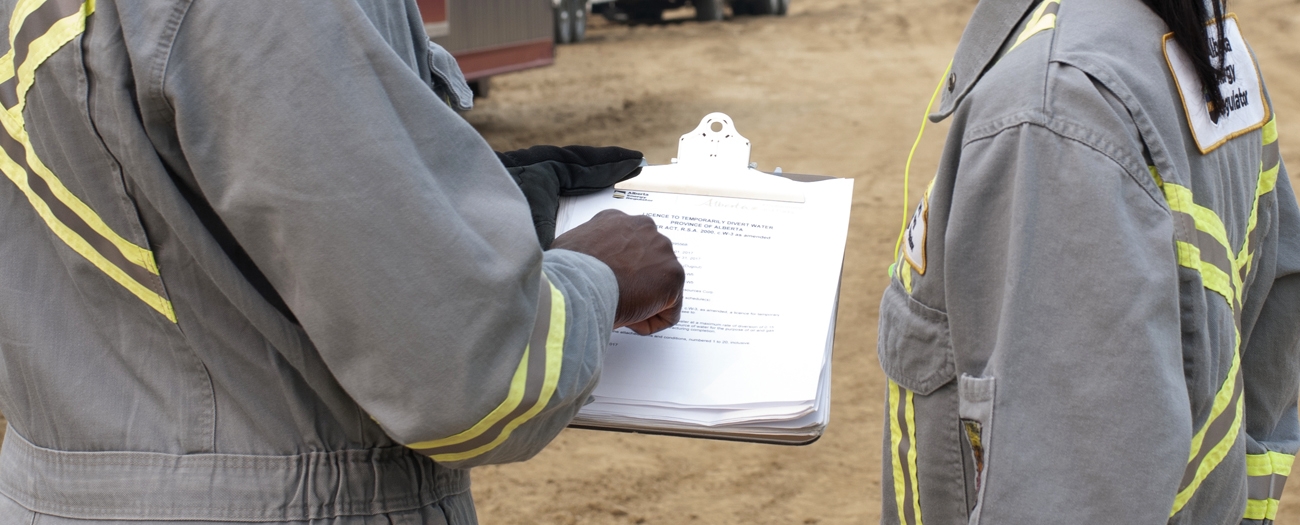Timeline
Our estimated processing time for this application is 30 business days. See Injectivity Test on our timeline spreadsheet for updates.
Purpose of the Application
Companies usually make a request for temporary injection before starting construction on permanent injection lines. Temporary injection is used to determine the injection capacity of a well when there is uncertainty. It is also used for emergency situations, such as plant shut downs, when pipeline fluids must be temporarily stored. Temporary injection is a short-term (typically three months) well injection period. Fluids such as produced water are often injected.
In few cases, we allow companies to carry out a temporary injection without submitting an application. In these cases, a company can inject a maximum cumulative water volume of 500 m3 to collect data for Directive 051: Injection and Disposal Wells – Well Classifications, Completions, Logging, and Testing Requirements and Directive 065: Resources Applications for Oil and Gas Reservoirs applications.
If the total water injection volume is more than 500 m3, the company must submit a Directive 065 injectivity test application for our approval. Section 10.060 of the Oil and Gas Conservation Rules provides more information.
Process Checklist
Submit an Application
Companies must submit their applications through our Digital Data Submission (DDS) system. We will register each application and assign it a reference number.
By submitting an application, the company accepts that its information is no longer confidential.
Review Process
- We share all applications on our Public Notice of Application page to encourage public participation in the approval process.
- Anyone who believes that they may be directly and adversely affected by an application can file a statement of concern (SOC). If we receive an SOC, it may take us longer to process the application.
- We will assign the application to a subject matter expert for initial review. If information is missing (i.e., the application is not complete and Directive 065 requirements are not met), we will close the application. Otherwise, we will proceed with a full technical review. We look at the following:
- whether the applicant has consent to inject into the target formations for the injectivity test. If so, there is no need to further notify any other parties because the volume of fluid to be injected is small and the injection duration is temporary. However, further notification may be required if it is determined that the proposed injection volumes and pressures could impact wells not operated by the applicant, thus causing concerns about equity and hydraulic isolation.
- what are the injection formation(s)
- why is the test needed and what are the factors that would lead to a successful injection
- whether the proposed test injection (volume and rates) would be detrimental to oil recovery
- whether the injectant contains H2S (sour gas). If so, an up-to-date, AER-approved emergency response plan must be in place.
- We will decide if Directive 051 requirements need to be met on a case-by-case basis. If the test exceeds 14 days, the requirements must be met.
- If the injection volume significantly exceeds 500 m3, Directive 051 requirements must be met. We may ask the applicant to submit Directive 051 data with the application.
- The requested maximum wellhead injection pressure (MWHIP) must be submitted with supporting technical documentation, unless the MWHIP prescribed in Table 1 of Appendix O in Directive 065 is used. If the test is meant to determine the fracture propagation pressure only, this must be specified in the application.
- We may request additional information (through a supplemental information request) to complete the technical review.
- We will decide to approve, close, or deny the application. If we close it, the applicant may reapply without prejudice. If we deny it, the applicant can file an appeal through our appeal process.
- If we approve the application, we will also provide conditions, including the approved injectivity test period and maximum injection volumes.
- We will provide the applicant with a link to the letter with our decision, which is accessible through the Integrated Application Registry Query, and we will share our decision on our Publication of Decision page.


